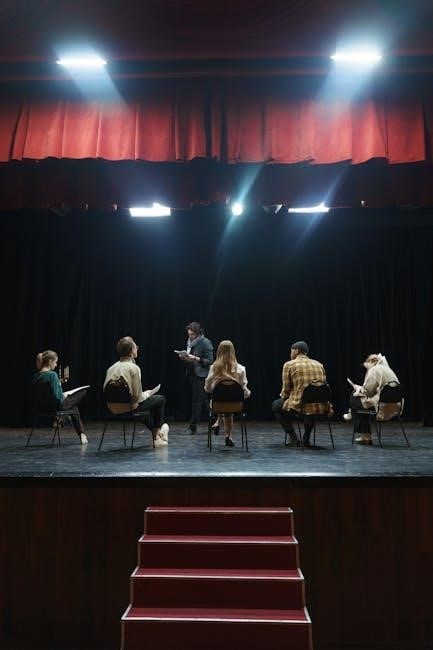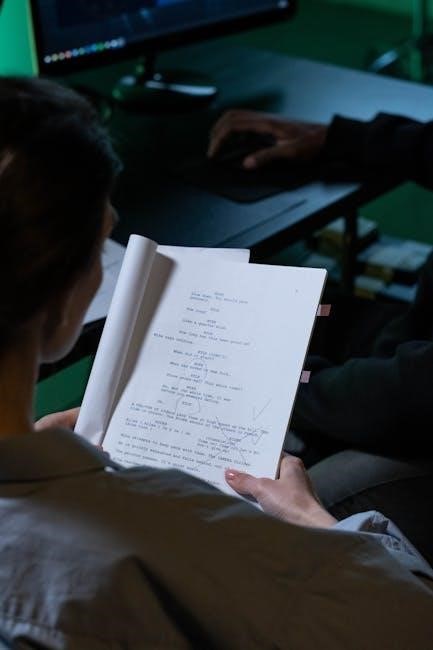“Clue: The Play” is a captivating theatrical adaptation of the iconic board game, bringing its timeless mystery to life on stage. This engaging script combines suspense, humor, and intricate storytelling, inviting audiences to unravel the enigma alongside the characters. The play’s dynamic dialogue and clever plot twists ensure a thrilling experience for both fans of the game and newcomers alike.
1.1 Overview

“Clue: The Play” is a theatrical adaptation that masterfully transforms the beloved board game into a live stage experience. The story revolves around the mysterious death of Mr. Boddy, with a cast of colorful suspects attempting to unravel the truth. Set in the grand Boddy Manor, the play captures the essence of the game, blending witty dialogue, clever plot twists, and engaging character interactions.
The script maintains the original game’s suspense and humor while expanding on the characters’ personalities and motivations. It is divided into three acts, each advancing the mystery and keeping the audience guessing. The play’s structure encourages active participation, as viewers piece together clues alongside the characters.
With its dynamic pacing and interactive elements, “Clue: The Play” appeals to both long-time fans of the board game and newcomers. The script’s adaptability allows for various staging interpretations, making it a versatile choice for theater groups. Its blend of mystery, comedy, and drama ensures an entertaining experience for all audiences.

1.2 Historical Context
“Clue: The Play” emerges from the rich legacy of the classic board game, which was first introduced in 1944 by Anthony E. Pratt. The game’s enduring popularity led to various adaptations, including films, TV shows, and eventually, a stage play. The play adaptation captures the essence of the game while expanding its narrative depth and character development, making it a unique addition to the Clue franchise.
The theatrical version of Clue was developed to bring the interactive mystery of the board game to life on stage. By adapting the game’s core elements—such as the suspects, weapons, and locations—the play offers a fresh perspective on the timeless whodunit story. The script retains the game’s suspenseful and comedic elements, appealing to both longtime fans and new audiences.

Historically, the play serves as a testament to the versatility of the Clue brand, which has evolved from a board game into a multimedia phenomenon. The availability of the script in PDF format has further democratized access, allowing theater groups worldwide to stage productions. This adaptation reflects the enduring appeal of mystery and deduction, solidifying Clue: The Play as a significant part of the franchise’s legacy.
Background and Origins
Clue: The Play originated as an adaptation of the beloved board game, transforming its interactive mystery into a live theatrical experience. The adaptation aimed to capture the game’s essence, bringing its iconic characters and intricate plot to the stage for both fans and newcomers to enjoy.
2.1 Adaptation from the Board Game
The adaptation of Clue: The Play from the board game retains the core mystery and detective elements that made the game iconic. The stage version captures the suspenseful atmosphere, translating the game’s interactive nature into a structured narrative. While the play expands on the characters and plot, it stays true to the original premise of solving a murder mystery. Key locations from the game, such as the study and library, are reimagined as sets, maintaining the familiar setting. The adaptation also incorporates the game’s signature elements, like weapons and clues, woven seamlessly into the dialogue and plot. By focusing on character dynamics and a scripted storyline, the play offers a fresh yet faithful interpretation of the beloved board game, appealing to both long-time fans and newcomers. The transition from a player-driven experience to a passive audience engagement required creative storytelling, ensuring the mystery remains engaging without direct interaction. This adaptation successfully bridges the gap between the game and theater, offering a unique experience that honors its origins while standing on its own as a compelling theatrical production.
2.2 The Playwright’s Vision

The playwright’s vision for Clue: The Play was to transform the beloved board game into a dynamic, engaging theatrical experience. The goal was to expand on the game’s iconic characters and settings, infusing them with depth and backstory to create a more immersive story. By maintaining the game’s core mystery while adding layers of humor and intrigue, the playwright aimed to craft a narrative that would captivate both fans of the original game and newcomers. The adaptation focuses on balancing suspense with witty dialogue, ensuring the play remains faithful to its source material while offering a fresh perspective. The playwright also emphasized the importance of character interactions, using the stage to explore their motivations and relationships. This vision ensures that the play is not just a direct translation but a reimagined story that thrives in the theatrical medium. The result is a production that honors the game’s legacy while introducing it to a new audience in an innovative way.

Plot Summary
“Clue: The Play” follows a mysterious death at Mr. Boddy’s mansion, sparking a thrilling investigation. A group of strangers, each with secrets, must unravel the truth behind the murder. As alliances form and clues surface, the plot twists and turns, blending humor, suspense, and clever reveals to keep audiences guessing until the final revelation.
3.1 Act 1: The Mystery Unfolds
The play opens in the grand but eerie Boddy Manor, where a group of strangers has been summoned for a mysterious dinner party. The atmosphere is tense from the start, with each guest harboring secrets and suspicions. As the evening progresses, the host, Mr. Boddy, reveals his knowledge of their individual misdeeds, setting the stage for conflict.
The act takes a dramatic turn when the lights flicker and a gunshot rings out. The guests discover Mr. Boddy’s lifeless body, and panic sets in. Wadsworth, the butler, takes charge, guiding the group through the initial stages of the investigation. Clues begin to surface, including a mysterious letter opener, a rope, and a revolver, each hinting at a possible weapon.
The suspects—Miss Scarlet, Colonel Mustard, Mrs. White, Mrs. Peacock, and Professor Plum—each react differently to the unfolding events. Their interactions reveal underlying tensions and alliances, adding layers to the mystery. As Act 1 concludes, the audience is left with more questions than answers, eager to see how the investigation will unfold in the next act.
3.2 Act 2: The Investigation
Act 2 delves deeper into the mystery as the suspects begin to investigate Mr. Boddy’s murder. The group, now aware of the gravity of the situation, starts to piece together the events of the evening. Wadsworth, the butler, takes charge, methodically questioning each guest and examining the clues left behind.
The act is filled with tension as alliances form and tempers flare. Miss Scarlet and Colonel Mustard’s rivalry becomes more pronounced, while Mrs. Peacock’s nervous demeanor raises suspicions. Professor Plum, ever the intellectual, takes a more analytical approach, trying to connect the dots between the clues.
Key moments include the discovery of a hidden room and the revelation of a secret passage, both of which provide crucial information. The group uncovers a letter opener, a rope, and a revolver, each potentially the murder weapon. However, the killer’s identity remains elusive, with each suspect seemingly having a plausible alibi.

As the act progresses, the audience is kept guessing, with red herrings and unexpected twists keeping the suspense high. The servants, particularly the enigmatic Mrs. White, begin to reveal more about their knowledge of the household, adding layers to the mystery.
By the end of Act 2, the group realizes they are trapped in the manor with the killer, and the stakes have never been higher. The investigation has only deepened the enigma, leaving everyone—both the characters and the audience—eager to uncover the truth in the final act.
3.3 Act 3: The Revelation
Act 3 of Clue: The Play delivers a gripping climax as the mystery reaches its peak. The remaining characters gather in the grand study, where the final clues are pieced together. Tensions rise as alliances are exposed, and the true culprit begins to unravel under the pressure of mounting evidence.
In a dramatic showdown, the killer is revealed, and their motives are laid bare. The playwright masterfully weaves together the seemingly unrelated clues, creating a shocking yet satisfying conclusion. The audience is kept on the edge of their seats as the truth unfolds, with twists that challenge even the most astute observers.
The final act also ties up loose ends, resolving the fates of all characters. The play ends with a sense of closure, yet leaves room for reflection on the intricate web of secrets and lies. The revelation not only solves the murder but also highlights the themes of deception and human nature, making it a memorable and thought-provoking finale to the production.

Key Characters
The key characters in Clue: The Play are a diverse group of suspects, each with distinct personalities and motives. From the cunning Miss Scarlet to the charm of Colonel Mustard, every character brings depth and humor to the story. Their interactions and rivalry fuel the suspense, while their dynamics reveal darker themes of greed and ambition, making them unforgettable.
4.1 Miss Scarlet
Miss Scarlet is one of the most intriguing and complex characters in Clue: The Play. Known for her sharp wit, charm, and cunning nature, she is a central suspect in the mystery. Her flirtatious demeanor and manipulative tactics make her a formidable figure, often keeping others on edge. Miss Scarlet’s backstory, hinted at through clever dialogue, suggests a life of secrets and hidden agendas, adding depth to her character. Her interactions with other suspects, particularly Colonel Mustard, reveal a web of alliances and rivalries that drive the plot forward. Miss Scarlet’s ability to think quickly and stay one step ahead makes her both a compelling and unpredictable character. Throughout the play, her motives are constantly questioned, keeping the audience guessing. Her presence is pivotal to the unfolding drama, as her actions and decisions significantly impact the outcome of the story. Miss Scarlet’s dynamic personality and mysterious past make her a standout character in the production, ensuring her lasting impression on the audience.

4.2 Colonel Mustard
Colonel Mustard is a pivotal and enigmatic character in Clue: The Play, embodying a mix of charm, arrogance, and underlying suspicion. His military background and self-assured demeanor often lead him to take charge of situations, but his true motives remain unclear. Colonel Mustard’s interactions with other characters, particularly Miss Scarlet, are laced with tension and hidden agendas, making their dynamic a focal point of the play; His sharp wit and ability to manipulate conversations often mask his own secrets, leaving both the audience and the other characters questioning his trustworthiness.
Throughout the play, Colonel Mustard’s dialogue reveals hints of a mysterious past, suggesting he may be hiding more than he lets on. His rivalry with Miss Scarlet is a recurring theme, as their verbal sparring often escalates into dramatic confrontations. Despite his confident exterior, Colonel Mustard’s actions betray a sense of desperation, indicating that he may be more deeply entangled in the mystery than he admits. His decisions and revelations play a crucial role in unraveling the plot, making him a key player in the story’s progression.

Colonel Mustard’s character adds layers of complexity to the play, blending humor, intrigue, and suspense. His unpredictable behavior keeps the audience engaged, as his true intentions remain a mystery until the very end. His interactions with the other suspects not only advance the plot but also highlight the darker aspects of his personality, making him a memorable and intriguing figure in Clue: The Play.





